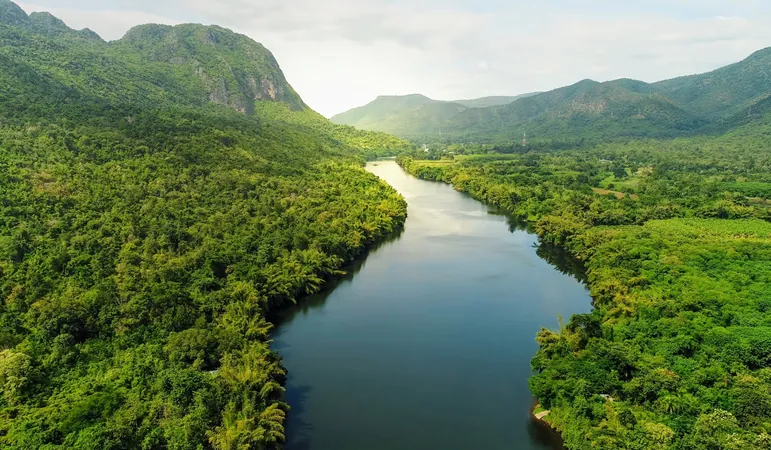
Microplastics Surge in Freshwater: A Growing Environmental Crisis
2024-11-04
Author: Arjun
As the world grapples with an escalating plastic pollution crisis, a groundbreaking study from Penn State reveals the alarming rise of microplastics in freshwater ecosystems—pointing fingers at decades of unchecked industrial growth.
The Data Behind the Dilemma
This extensive research, spearheaded by a multidisciplinary team at Penn State, meticulously traced microplastic levels in freshwater sediments back to the 1950s. What they found is a concerning parallel: a relentless increase in microplastic concentrations correlating directly with the global boom in plastic production.
Nathaniel Warner, an associate professor of civil and environmental engineering, emphasized the significance of the findings: “Our study is pioneering in tracking microplastic levels in freshwater sediments from before the 1950s to the present, illustrating a direct link to plastic manufacturing rates.”
What Are Microplastics?
Microplastics are tiny plastic particles, measuring anywhere from one-hundredth the diameter of a human hair to roughly the size of a pencil eraser. They pose a growing threat to aquatic life and human health, as they can easily infiltrate food and water sources.
The research covered sediment samples from four distinct watersheds in Pennsylvania: the Kiskiminetas River, Blacklick Creek, Raystown Lake, and Darby Creek. Intriguingly, the results indicated that microplastic concentrations remained high irrespective of nearby population density or land development.
The Recycling Impact
Lisa Emili, an associate professor specializing in physical geography and environmental studies, noted notable revelations within the data, stating, “Our findings suggest that traditional factors such as population density and developed land percentage aren’t the driving forces behind microplastic variation.”
Between 2010 and 2020, a significant decrease in microplastic accumulation was observed—a timeline that aligns with intensified recycling initiatives across the U.S. The U.S. Environmental Protection Agency corroborates this, reporting a marked expansion in recycling activities from 1980 to 2010.
Why Can't We Find the Plastics?
Raymond Najjar, a professor of oceanography, provided insights into the "missing plastics" phenomenon—the vast disparity between anticipated ocean plastic waste and what is seen on the surface. He proposes that estuaries and tidal marshes could be acting as reservoirs, capturing plastics and preventing them from contaminating the open ocean.
“This could shed light on the scarcity of surface plastic in oceans, despite predictions of abundant riverine inputs,” explained Najjar.
The Urgent Call for Change
The research team warns of the forecasted increase in microplastic levels in both water bodies and sediments. "Our ingestion of plastics through food and drinks, coupled with inhalation from the air, is a growing concern with unknown long-term health consequences," stated Warner. "It’s imperative that we develop strategies to limit our plastic release into the environment while reducing overall consumption."
Collaborative Efforts Spur New Directions
This diverged research initiative pulled together expertise from various disciplines, including chemistry, engineering, hydrology, oceanography, and soil science. Emili underscored the importance of interdisciplinary collaboration, remarking on its role in advancing understanding of microplastic fate in freshwater systems, particularly in coastal settings.
Looking ahead, Warner aims to track changes in microplastic composition over time and investigate the associated health risks, with a keen interest in the land-to-sea journey of these pollutants.
Supported by the U.S. National Science Foundation, Penn State’s Commonwealth Campus Center Nodes (C3N) Program, and the Institute of Energy and the Environment, this study aims to shed light on the burgeoning challenge of plastic pollution while proposing long-term, actionable solutions for mitigating its impact.
The full research findings are published in the esteemed journal *Science of The Total Environment*.


 Brasil (PT)
Brasil (PT)
 Canada (EN)
Canada (EN)
 Chile (ES)
Chile (ES)
 España (ES)
España (ES)
 France (FR)
France (FR)
 Hong Kong (EN)
Hong Kong (EN)
 Italia (IT)
Italia (IT)
 日本 (JA)
日本 (JA)
 Magyarország (HU)
Magyarország (HU)
 Norge (NO)
Norge (NO)
 Polska (PL)
Polska (PL)
 Schweiz (DE)
Schweiz (DE)
 Singapore (EN)
Singapore (EN)
 Sverige (SV)
Sverige (SV)
 Suomi (FI)
Suomi (FI)
 Türkiye (TR)
Türkiye (TR)